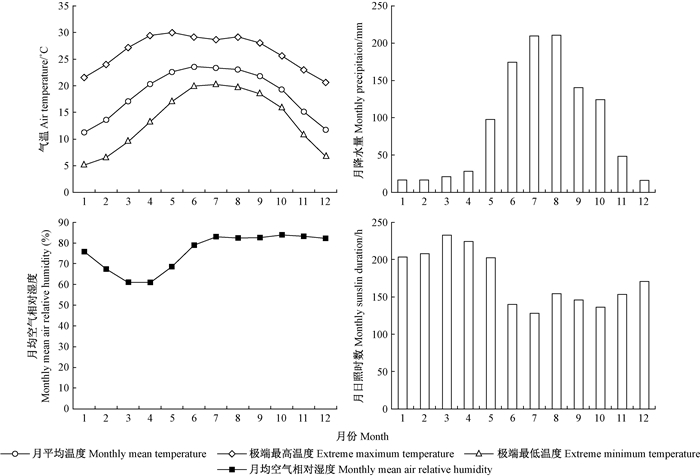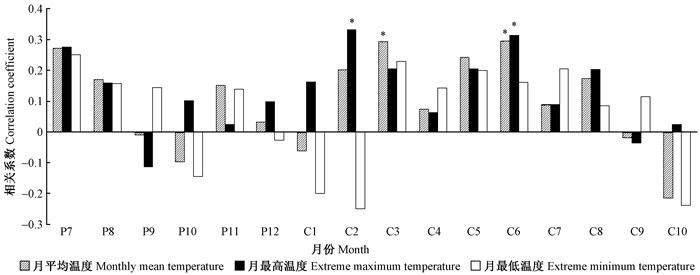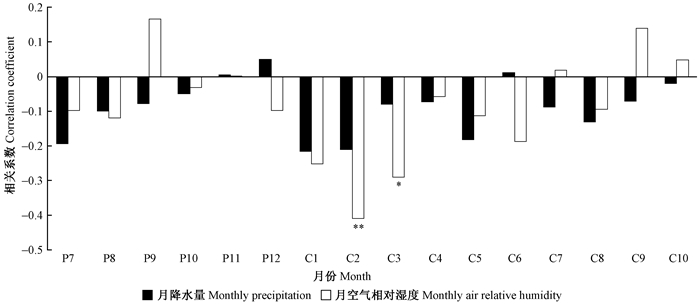文章信息
- 白雪, 范泽鑫
- Bai Xue, Fan Zexin
- 哀牢山中山湿性常绿阔叶林水青树年轮宽度对气候变化的响应
- Response of Tree Ring Width to Climate Change of Tetracentron sinensis in Humid Evergreen Broad-Leaved Forest in the Middle Ailao Mountains
- 林业科学, 2018, 54(3): 161-167.
- Scientia Silvae Sinicae, 2018, 54(3): 161-167.
- DOI: 10.11707/j.1001-7488.20180317
-
文章历史
- 收稿日期:2016-06-20
- 修回日期:2018-02-05
-
作者相关文章
2. 中国科学院大学 北京 100049
2. University of CAS Beijing 100049
全球气候变化及其对生态系统和人类生存环境的影响,已成为世界瞩目的焦点(Trumbore et al., 2015)。研究过去气候变化及其规律是研究全球气候变化的核心之一(李军龙等,2011)。树木年轮具有分辨率高、连续性强、复本易得等特点,在全球气候变化研究领域具有不可替代的价值(吴祥定,1990),被广泛应用于重建高分辨率气候和环境变化历史,尤其是对高寒、干旱及半干旱区气候和环境变化的研究(李雁等,2008;徐宁等,2008;Scott,2014)。在我国北方干旱区和青藏高原,利用树木年轮数据重建过去几个世纪乃至千年气候变化历史取得了重要进展(邵雪梅等,2007;Yang et al., 2015;Zhang et al., 2015)。然而,在亚热带地区开展树木年代气候学的研究相对较少(Oliveira et al., 2010),且集中在黄山松(Pinus taiwanensis)(郑永宏等,2012;彭剑锋等,2013)、马尾松(Pinus massoniana)(王瑞丽等,2011;董志鹏等,2014)、冷杉(Abies fabri)(侯鑫源等,2015)和樟(Cinnamonmum camphora)(王兵等,2009)等树种的径向生长特征及其对气候变化的响应方面。亚热带的树木年轮在重建过去气候变化方面具有很大的潜力(Worbes,1999;Kris et al., 2010;Shi et al., 2010;Zheng et al., 2012;Duan et al., 2013;史江峰等,2009;Liu et al., 2009)。
云南省哀牢山纵贯云南中南部,为云岭向南的延伸,是云贵高原和横断山脉的分界线。由于青藏高原的隆起阻挡了干热的环流西风,同时加强了东亚季风对这一地区的影响,特别是东南季风和西南季风在这里交汇,使得该地区降雨充沛,培育了湿润性的常绿阔叶林。受季风气候影响,本区有明显的干湿季之分,且干季与低温同期。地处过渡带上的哀牢山中山湿性常绿阔叶林是常绿阔叶林分布的海拔上限,对气候变化尤为敏感,山地上树木的生长节律明显,部分树种的年轮结构清晰(谢寿昌等,1996)。探究该地区的树木年轮与气候因子的关系,对了解全球变暖背景下云南中部的区域气候变化具有重要意义。水青树(Tetracentron sinense)是水青树科(Tetracentraceae)仅存的阔叶落叶树种,是第三纪古老孑遗珍稀植物,其木质部结构特殊,仅具有管胞而缺乏导管(张萍,1999),年轮清晰,具有进行年轮气候学研究的潜力。本研究基于在哀牢山国家级自然保护区所采的水青树年轮样本,建立树木年轮宽度标准化年表,分析树木年轮宽度年表与气候因子的关系,以期为进一步重建我国西南亚热带地区过去气候变化历史提供基础数据为全球变化背景下水青树的分布和保护研究提供理论依据。
1 研究区概况研究区位于云南哀牢山(101.02°—101.22°E,24.54°—24.67°N),在其海拔2 200~2 600 m处分布着亚热带中山湿性常绿阔叶林,面积约504 km2,是我国原始常绿阔叶林分布面积最大的地区。地带性植被以壳斗科(Fagaceae)植物占优势,其次为樟科(Lauraceae)、木兰科(Magnoliaceae)和山茶科(Theaceae)。受季风气候影响,该地区降水充沛,年降水量1931.1 mm,其中雨季(5—10月)占年降水量的85%,年蒸发量1 485 mm,年均空气相对湿度83%。年均气温为11 ℃,最热月为6月,极端最高气温25 ℃,最冷月为1月,极端最低气温-8.3 ℃,全年无霜期180天。
哀牢山中山湿性常绿阔叶林的土壤为山地黄棕壤,pH值为4.3,有机质含量为9%~12%(刘文耀等,1995)。林中分布着一定比例的落叶树种,如滇杨(Populus yunnanensis)、珍珠花(Lyonia ovalifolia)和藏南槭(Acer campbellii)等,其中水青树为珍稀落叶阔叶树种,是被子植物中少数木质部缺乏导管的种类之一。水青树分布范围为98°—111.5°E,24°—34.5°N,主要分布在海拔1 500~2 400 m的中山地带。水青树在哀牢山中山湿性常绿阔叶林中呈零星分布,主要发现于山谷附近土层较厚、气候阴湿的生境,一般展叶开始于4月中下旬,花期为6—7月,9—10月落叶。
2 研究方法 2.1 样品采集与年表建立在云南省哀牢山国家自然保护区徐家坝附近采集水青树年轮样芯,采样点海拔2 400~2 500 m,属水青树生长的海拔上限。水青树散点状分布在常绿阔叶林中,采样时选取径级较大树木个体,用生长锥(内径5 mm)在胸高处采集样芯,每棵树采集2~3个样芯,共采集水青树样品50株。样品带回实验室风干后,固定于特制木槽内,用不同颗粒度的砂纸(400目至2000目)打磨,直至木材横切面年轮清晰可见。利用Lintab 6.0 (Rinntech, Germany)树木年轮测量仪测定年轮宽度(精度0.001 mm),在TSAPWin软件的帮助下,通过曲线比较和统计检验进行交叉定年,精确确定每个年轮的生长年份。剔除生长异常和不能定年的样芯,最终获得来自35棵树(62个样芯)的年轮宽度序列。通常树木生长速率随年龄增长而减慢,为消除与树木年龄相关的生长趋势及部分树木之间的非一致扰动,去除非环境噪声,对每一序列进行标准化处理。利用ARSTAN软件(Cook et al., 1981; Cleveland,1979),采用负指数和步长为序列2/3的样条函数进行去趋势,去除与年龄相关的生长趋势及树木间干扰竞争引起的非一致性波动等。最终以双权重法建立水青树标准年表、差值年表和自回归年表。本研究利用标准年表与气候因子进行相关分析。通过样芯间的相关系数和样本总体代表性来评估年表的可靠性。
2.2 气象数据来源哀牢山亚热带生态系统研究站自1982年有气象观测记录,但数据时段较短且不连续。本研究选取距采样点较近的云南景东县气象站(100.87°E,24.47°N)1956—2014年的气象资料,主要包括月降水量、月均空气相对湿度、月气温及月日照时数。从景东气象站长期气候变化平均状况(图 1)可看出,本地区有明显的干湿季节,5—10月为雨季,高温多雨,11月至翌年4月为干季,低温少雨。干季2—4月份湿度较低,日照较长。气象数据来源于中国气象科学数据共享网(http://cdc.nmic.cn)。

|
图 1 景东气象站月气温、月降雨量、月均空气相对湿度和月日照时数(1956—2014) Figure 1 Monthly variations of air temperature, precipitation, mean air relative humidity and sunshine duration of Jingdong meteorological station(1956-2014) |
从表 1可看出,哀牢山水青树树木径向生长速率较快,平均达2.11 mm·a-1,最大树龄为227年。树轮宽度年表平均树间相关系数为0.511,说明该年表有较好的区域一致性,可代表该地区水青树平均生长状况。平均敏感度主要反映树木年际间的生长变化情况(吴祥定,1990),水青树年轮宽度年表的平均敏感度为0.221,表明该年表中包含着较多的高频信号;一阶自相关系数为0.487,表明前1年的气候条件对水青树生长有一定影响;同时,样本总体代表统计量达到0.85,表明年表的样本量能代表该地区的总体特征。这些指标可以说明本地区的水青树适用于年轮气候学分析。
|
|
考虑到气候对树木生长具有一定的滞后效应,本研究选取上一年7月到当年10月的月均气候因子与水青树标准年表进行相关分析。气候因子变量包括月平均气温、极端最高气温、极端最低气温、月降水量、月均空气相对湿度和月日照时数。水青树年轮宽度年表与景东县气象站的气象数据相关分析表明,水青树的径向生长与当年2和6月的平均气温和极端最高气温显著正相关(P<0.05)(图 2),与当年2月的月日照时数显著正相关(P<0.05)(图 3)。水青树年轮宽度年表与月均降水量和月均空气相对湿度负相关,但相关性不高,仅当年2和3月的空气相对湿度与年表极显著相关(P<0.01)(图 4)。

|
图 2 年轮宽度年表与月气温的相关系数 Figure 2 Correlation coefficients between tree ring-width chronology and monthly temperature *:P<0.05;**:P<0.01;P:前一年Pre-year;C:当年Current year.下同The same below. |

|
图 3 年轮宽度年表与月平均日照时数的相关系数 Figure 3 Correlation coefficients between tree ring-width chronology and monthly sunshine durations |

|
图 4 年轮宽度年表与月平均降水量和空气相对湿度的相关系数 Figure 4 Correlation coefficients between tree ring-width chronology and monthly precipitation and relative humidity |
由表 2可知:在生长季(夏季湿热期),水青树年轮宽度年表与气温显著正相关(P<0.05);而在生长季前期(冬春冷干期),年轮宽度与月均空气相对湿度极显著负相关(P<0.01),而与日照时数显著正相关(P<0.05);年轮宽度年表与各个时期的降水量均负相关,但相关性不显著(表 2)。
|
|
本研究发现,哀牢山中山湿性常绿阔叶林中水青树的年轮宽度年表与生长季前期的气温和月日照时数显著正相关(图 2,3和表 2)。水青树为落叶树种,每年10月末到11月上旬叶全部枯萎脱落,芽休眠,以度过冬季冷干期;翌年2月末到3月中旬,芽萌发,形成花序或新枝(张萍,1999),这一时期的气温和日照是影响水青树径向生长的关键因子。气温升高和日照时数增加有利于水青树形成层活动,以获得更多营养物质,促进树木的径向生长(程瑞梅等,2015),生长季前期较高的气温和充足的日照也有利于延长树木有效光合作用时长,积累碳同化产物,供树木尽早开始形成早材(Gou et al., 2007)。Duan等(2013)在我国东部亚热带利用31个样点的马尾松年轮宽度数据分析得出,1—3月气温是影响亚热带地区马尾松树木径向生长的主要气候因子,1—3月的低气温可能导致马尾松树木径向生长延迟,生长期变短,形成窄轮;Chen等(2015)研究也表明,亚热带地区的树种不像高海拔高纬度地区的树种一样在冬季完全休眠,暖冬会减少根叶的伤害,从而减少对树木的生长限制。
然而,生长季前期较高的空气相对湿度则会抑制水青树的径向生长,形成窄轮(图 4,表 2)。这种作用可能是间接的,较高的空气相对湿度主要由于云雾量增多所致,云雾量的增加会减少日照强度和时长,从而降低水青树光合速率乃至生长(Zhu et al., 2009; Duan et al., 2012; Takahashi et al., 2005),成为影响水青树径向生长的限制因子,导致形成窄年轮。吴普等(2005)在四川小金地区的研究也证明,较高的空气相对湿度和较少的日照时数,会间接降低净光合作用产物的累积,导致树木年轮最大密度减小。李玲玲等(2014)的研究也表明,高降水量、高空气相对湿度及其对应的高云量对树木生长存在抑制作用。
5 结论本研究利用生长于云南哀牢山中山湿性常绿阔叶林中的落叶植物水青树为材料,利用树木年轮学的方法成功建立了该树种树轮宽度年表。与气象数据相关分析表明:水青树径向生长受生长季气温和生长季前期日照时数影响较大。该结果表明在温暖潮湿的亚热带森林,水青树的树木年轮宽度年表具有明确的气候信号,具有重建过去气候变化的潜力。研究结果可为全球变化背景下水青树的分布预测和保护生物学研究提供理论参考,为进一步重建我国西南亚热带地区的过去气候变化历史提供基础。
程瑞梅, 刘泽彬, 封晓辉, 等. 2015. 气候变化对树木木质部生长影响的研究进展[J]. 林业科学, 51(6): 147-154. (Cheng R M, Liu Z B, Feng X H, et al. 2015. Advances in research on the effect of climatic change on xylem growth of trees[J]. Scientia Silvae Sincae, 51(6): 147-154. [in Chinese]) |
董志鹏, 郑怀舟, 方克艳, 等. 2014. 福建三明马尾松树轮宽度对气候变化的响应[J]. 亚热带资源与环境学报, 9(1): 1-7. (Dong Z P, Zheng H Z, Fang K Y, et al. 2014. Responses of tree-ring width of Pinus massiniana to climate change in Sanming, Fujian Province[J]. Journal of Subtropical Resources and Environment, 9(1): 1-7. [in Chinese]) |
侯鑫源, 史江峰, 李玲玲, 等. 2015. 湖北神农架巴山冷杉径向生长对气候的响应[J]. 应用生态学报, 26(3): 689-696. (Hou X Y, Shi J F, Li L L, et al. 2015. Growth response of Abies fargesii to climate in Shenongjia Mount of Hubei Province, southeastern China[J]. Chinese Journal of Applied Ecology, 26(3): 689-696. [in Chinese]) |
李军龙, 徐雯. 2011. 树轮宽度对气候变化响应的研究进展[J]. 西南林业大学学报, 31(3): 86-91. (Li J L, Xu W. 2011. Research progress in the study on response of tree ring width to climatic change[J]. Journal of Southwest Forestry University, 31(3): 86-91. [in Chinese]) |
李玲玲, 史江峰, 侯鑫源, 等. 2014. 中国东南高海拔黄山松生长对气候的响应——以浙江省九龙山和安徽省牯牛降为例[J]. 应用生态学报, 25(7): 1849-1856. (Li L L, Shi J F, Hou X Y, et al. 2014. High altitude Pinus taiwanensis hayata growth response to climate in Jiulongshan and Guniujiang, southeastern China[J]. Chinese Journal of Applied Ecology, 25(7): 1849-1856. [in Chinese]) |
李雁, 梁尔源, 邵雪梅. 2008. 柴达木盆地东缘青海云杉树轮细胞结构变化特征及其对气候的指示[J]. 应用生态学报, 19(3): 524-532. (Li Y, Liang E Y, Shao X M. 2008. Variations of Picea crassifolia tree-ring cell structure and their implications to past climate in eastern margin of Qaidam Basin, northwest China[J]. Chinese Journal of Applied Ecology, 19(3): 524-532. [in Chinese]) |
刘文耀, 谢寿昌, 谢克金, 等. 1995. 哀牢山中山湿性常绿阔叶林凋落物和粗死木质部的初步研究[J]. 植物学报, 37(10): 807-814. (Liu W Y, Xie S C, Xie K J, et al. 1995. Prelminary studies on the litterfall and coarse woody debris in mid-mountain humd evergreen broad-leaved forest in Ailao Mountains[J]. Acta Botanica Sinica, 37(10): 807-814. [in Chinese]) |
彭剑锋, 孙小华, 王飞, 等. 2013. 西大别山百战坪黄山松径向生长对气候因子的响应[J]. 生态环境学报, 22(11): 1769-1773. (Peng J F, Sun X H, Wang F, et al. 2013. Climatic signals from the radial growth of Huangshan pine (Pinus taiwanese's Hayata) in the western Dabie Mountains[J]. Ecology and Enviromental Sciences, 22(11): 1769-1773. [in Chinese]) |
邵雪梅, 王树芝, 徐岩, 等. 2007. 柴达木盆地东北部3500年树轮定年年表的建立[J]. 第四纪研究, 4: 477-485. (Shao X M, Wang S Z, Xu Y, et al. 2007. A 3500-year master tree-ring dating chronology from the northeastern part of the Qaidam Basin[J]. Quaternary Sciences, 4: 477-485. [in Chinese]) |
史江峰, 鹿华煜, 万建东. 2009. 采用华山松树轮宽度重建秦岭东缘近半年冬半年温度[J]. 第四季研究, 29: 831-836. (Shi J F, Lu H Y, Wan J D. 2009. Winter-half year temperature reconstruction of the last century using Pinus armandii Franch tree-ring width chronology in the eastern Qinling Mountains[J]. Quaternary Sciences, 29: 831-836. [in Chinese]) |
王兵, 高鹏, 郭浩, 等. 2009. 江西大岗山林区樟树年轮对气候变化的响应[J]. 应用生态学报, 20(1): 71-76. (Wang B, Gao P, Guo H, et al. 2009. Responses of tree-ring width of Cinnamomum camphora to climate change in Dagangshan forest area of Jiangxi Province[J]. Chinese Journal of Applied Ecology, 20(1): 71-76. [in Chinese]) |
王瑞丽, 程瑞梅, 肖文发, 等. 2011. 北亚热带马尾松年轮宽度与NDVI的关系[J]. 生态学报, 31(19): 5762-5770. (Wang R L, Cheng R M, Xiao W F, et al. 2011. Relationship between masson pine tree-ring width and NDVI in north subtropical region[J]. Acta Ecologica Sinica, 31(19): 5762-5770. [in Chinese]) |
吴普, 王丽丽, 邵雪梅. 2005. 采用高山松最大密度重建川西高原近百年夏季气温[J]. 地理学报, 60(6): 998-1006. (Wu P, Wang L L, Shao X M. 2005. Reconstruction of summer temperature from maximum latewood density of Pinus densata in west Sichuan[J]. Acta Gengraphica Sinica, 60(6): 998-1006. [in Chinese]) |
吴祥定. 1990. 树木年轮与气候变化[M]. 北京: 气象出版社. (Wu X D. 1990. Tree-ring and climate change[M]. Beijing: Chinese Meteorological Press. [in Chinese]) |
谢寿昌, 刘文耀, 李寿昌, 等. 1996. 云南哀牢山中山湿性常绿阔叶林生物量的初步研究[J]. 植物生态学报, 20(2): 167-176. (Xie S C, Liu W Y, Li S C, et al. 1996. Preliminary studies on the biomass of middle-mountain moist evergreen broadleaved forests in Ailao Mountain, Yunnan[J]. Acta Phytoecologica Sinica, 20(2): 167-176. [in Chinese]) |
徐宁, 王晓春, 张远东, 等. 2008. 川西米亚罗林区不同海拔岷江冷杉生长对气候变化响应[J]. 生态学报, 33(12): 3742-3751. (Xu N, Wang X C, Zhang Y D, et al. 2008. Climate-growth relationships of Abies faxoniana from different elevations at Miyaluo, wesern Sichuan, China[J]. Acta ecologica Sinica, 33(12): 3742-3751. [in Chinese]) |
张萍. 1999. 水青树的地理分布及生态生物学特性研究[J]. 烟台师范学院学报, 15(2): 148-150. (Zhang P. 1999. Study of geogra phical distribution and biological properties of ecology on Tetracentron sinesis[J]. Journal of Yantai Normal College, 15(2): 148-150. [in Chinese]) |
郑永宏, 张永, 邵雪梅, 等. 2012. 大别山地区黄山松和油松年轮宽度的气候意义[J]. 地理科学进展, 31(1): 72-77. (Zheng Y H, Zhang Y, Shao X M, et al. 2012. Climate significance of tree ring width of Huangshan pine and Chinese pine in the Dabie Mountains[J]. Progeress in Geography, 31(1): 72-77. [in Chinese]) |
Chen F, Yuan Y J, Wei W S, et al. 2015. Tree-ring response of subtropical tree species in southeast China on regional climate and sea-surface temperature variations[J]. Trees, 29(1): 17-24. DOI:10.1007/s00468-013-0951-4 |
Cleveland W S. 1979. Robust locally weighted regression and smoothing scatterplots[J]. Journal of the American Statistical Association, 74(368): 829-836. DOI:10.1080/01621459.1979.10481038 |
Cook E R, Peters K. 1981. The smoothing spline:a new approach to standardizing forest interior tree-ring width series for dendroclimatic studies[J]. Tree-Ring Bulletin, 41: 45-53. |
Duan J P, Zhang Q B, Lü L X. 2013. Increased variability in cold-season temperature since the 1930s in subtropical China[J]. Journal of Climate, 26(13): 4749-4757. DOI:10.1175/JCLI-D-12-00332.1 |
Duan J P, Zhang Q B, Lü L X, et al. 2012. Regional-scale winter-spring temperature variability and chilling damage dynamics over the past two centuries in southeastern China[J]. Climate Dynamics, 39(3/4): 919-928. |
Gou X H, Chen F H, Jacoby G, et al. 2007. Rapid tree growth with respect to the last 400 years in response to climate warming, north Eastern Tibetan Plateau[J]. International Journal of Climatology, 27(11): 1497-1503. DOI:10.1002/(ISSN)1097-0088 |
Kris C, Jonathan B M, Henri D G, et al. 2010. Assessment of tree rings as a hydrologic record in a humid subtropical environment[J]. Journal of the American Water Resources Association, 46(5): 919-931. DOI:10.1111/jawr.2010.46.issue-5 |
Liu Y, Linderholm H W, Song H, et al. 2009. Temperature variations recorded in Pinus tabulaeformis tree rings from the southern and northern slopes of the central Qinling Mountains[J]. Boreas, 38(2): 285-291. DOI:10.1111/bor.2009.38.issue-2 |
Oliveira J M, Roig F A, Pillar V D. 2010. Climatic signals in tree-rings of Araucaria angustifolia in the southern Brazilian highland[J]. Austral Ecology, 35(2): 134-147. DOI:10.1111/aec.2010.35.issue-2 |
Scott S G. 2014. An overview of tree-ring width records across the Northern Hemisphere[J]. Quaternary Science Reviews, 95: 132-150. DOI:10.1016/j.quascirev.2014.04.029 |
Shi J F, Cook E R, Lu H Y, et al. 2010. Tree-ring based winter temperature reconstruction for the lower reaches of the Yangtze River in southeast China[J]. Climate Research, 41(2): 169-175. |
Takahashi K, Tokumitsu Y, Yasue K. 2005. Climatic factors affecting the tree-ring width of Betula ermanii at the timberline on Mount Norikura, central Japan[J]. Ecological Rearch, 20(4): 445-451. DOI:10.1007/s11284-005-0060-y |
Trumbore S, Brando P, Hartmann H. 2015. Forest health and global change[J]. Science, 349(6250): 814-818. DOI:10.1126/science.aac6759 |
Worbes M. 1999. Annual growth rings, rainfall-dependent growth and long-term growth problems of tropical trees from Caparo Forest Reserve in Venezuela[J]. Journal of Ecology, 87(3): 391-403. DOI:10.1046/j.1365-2745.1999.00361.x |
Yang B, Qin C, Wang J, et al. 2015. A 3500-year tree-ring record of annual precipitation on the northeastern Tibetan Plateau[J]. Preceedings of the National Academy of Sciences of the United States of America, 111(8): 2903-2908. |
Zhang Q, Evans M N, Lü L. 2015. Moisture dipole over the Tibetan Plateau during the past five and a half centuries[J]. Nature Communications, 6: 8062. DOI:10.1038/ncomms9062 |
Zheng Y H, Zhang Y, Shao X M, et al. 2012. Temperature variability inferred from tree-ring widths in the Dabie Mountains of subtropical central China[J]. Trees, 26(6): 1887-1894. DOI:10.1007/s00468-012-0757-9 |
Zhu H F, Fang X Q, Shao X M, et al. 2009. Tree ring-based February-April temperature reconstruction for Changbai Mountain in northeast China and its implication for East Asian winter monsoon[J]. Climate of the Past, 5(4): 661-666. DOI:10.5194/cp-5-661-2009 |
 2018, Vol. 54
2018, Vol. 54
